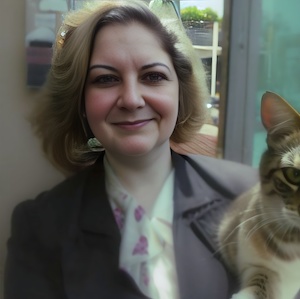If you’re a cat lover, you’ve undoubtedly witnessed the delightful sight of a cat curled up into what can only be described as a “loaf.” Perhaps you’ve wondered why your furry friend assumes this endearing and peculiar pose. Is it merely an accident of circumstance, or does it serve a purpose in the mysterious world of feline behavior?
In this article, we embark on a fascinating journey to explore the enigmatic phenomenon of cats loafing. Whether you’re a seasoned cat owner or simply an admirer of these enigmatic creatures, we’ll delve into the whys and hows behind their choice to adopt this cozy position.
So, grab a cup of tea, settle in, and let’s uncover the secrets behind our feline friends’ love for loafing!
Why Do Cats Loaf?
Cats are masters of body language, and they use various postures and gestures to communicate their mood, intention, and needs. Cat loafing is one of the most common and expressive positions that cats can assume, and it can have different meanings depending on the context and the individual cat. Here are some of the possible reasons why cats loaf:
- Relaxation and comfort: Cat loafing is usually a sign that your cat is feeling relaxed and comfortable in its environment. By tucking in its paws and tail, your cat is reducing its exposed surface area and conserving its body heat.
This makes your cat feel cozy and snug, especially if it is loafing on a warm and soft spot, such as your lap, clothes, furniture, or a sunny spot on the floor.
A relaxed cat loaf will have an upright head and ears, half-closed or blinking eyes, calm whiskers, and a slow or soft purr.

- Thermoregulation and heat retention: Cats are warm-blooded animals, which means they need to maintain a constant body temperature regardless of the external conditions.
A healthy cat’s normal body temperature ranges from 100.5 to 102.5 degrees Fahrenheit (38 to 39 degrees Celsius). To achieve this, cats use various mechanisms to regulate their heat production and loss, such as shivering, panting, sweating, grooming, and changing their posture.
Cat loafing is one of the ways that cats can retain their body heat by minimizing their heat loss through their extremities. This is especially useful for cats living in cold climates or seasons.
- Observation and curiosity: Cats are curious creatures by nature, and they like to explore their surroundings and keep an eye on what’s going on.
Cat loafing is a position that allows cats to observe their environment without being too conspicuous or vulnerable. By tucking in their paws and tail, cats can reduce their profile and blend in with their background.
This can help them avoid unwanted attention from predators or other cats, as well as sneak up on potential prey or playmates. A curious cat loaf will have an upright head and ears, fully open or dilated eyes, twitching whiskers, and a fast or shallow breathing.
- Protection and Security: Sometimes, cats loaf to protect themselves from potential threats or dangers. By hiding their paws and tail, cats are making themselves less vulnerable to attacks or injuries.
They are also making themselves less visible and less noticeable to predators or other animals. This can be a sign of stress, anxiety or fear in some cats, especially if they are in a new or unfamiliar environment.
- Communication and Signaling: Finally, cats loaf to communicate with other cats or humans. By sitting upright with their head and ears alert, cats are showing that they are paying attention to their surroundings and ready to interact if needed.
They are also signaling that they are confident and calm, and not looking for trouble. However, if they start to lower their head or close their eyes, they may be indicating that they want to be left alone or that they are feeling sleepy.
What Does Cat Loafing Mean?
As we have seen, cat loafing can have different meanings depending on the situation and the individual cat.
However, there are some general guidelines that can help you interpret your cat’s body language and understand what it is trying to tell you.

Here are some of the signs that can indicate your cat’s mood and intention while loafing:
- A relaxed, happy, or curious cat loaf will have an upright head and ears, half-closed or blinking eyes, calm whiskers, a slow or soft purr, a wrapped or tucked tail, flat or tucked paws, a normal or slightly elevated breathing rate, and a normal or slightly elevated body temperature.
- A stressed, anxious, or sick cat loaf will have a lowered head and ears, wide-open or dilated eyes, tense whiskers, a rapid or shallow breathing rate, a low or high body temperature, a limp or stiff tail, limp or stiff paws, no purring or vocalizing.
When to Be Concerned About Cat Loafing?
Cat loafing is usually normal and harmless behavior that indicates your cat’s comfort level and interest in its surroundings. However, sometimes it can also be a sign of a problem that requires your attention and care. Some of the possible causes of abnormal or excessive cat loafing are:
- Pain or discomfort in the limbs or joints: Cats are very good at hiding their pain and discomfort from others, as this can make them appear weak or vulnerable in the wild.
However, if your cat is suffering from arthritis, injury, infection, inflammation, or other conditions that affect its limbs or joints, it may resort to loafing as a way to relieve its pain or discomfort.
By tucking in its paws and tail, your cat is reducing the pressure on its affected areas, as well as protecting them from further damage. However, this can also limit your cat’s mobility and activity, and affect its quality of life.

- Infection or inflammation in the paws or tail: Cats use their paws and tail for various purposes, such as walking, running, jumping, climbing, scratching, grooming, playing, hunting, and communicating.
Therefore, any infection or inflammation in these areas can cause your cat a lot of pain and discomfort, and affect its normal functioning.
Some of the common causes of infection or inflammation in the paws or tail are: bites, wounds, abscesses, allergies, parasites, fungal infections, bacterial infections, or autoimmune diseases.
If your cat has any of these conditions, it may loaf to avoid touching or moving its affected areas, as well as to prevent further infection or inflammation.
- Obesity or diabetes affecting mobility or circulation: Cats are prone to obesity and diabetes , especially if they are fed a high-carbohydrate diet, have a sedentary lifestyle, or are spayed or neutered.
Obesity and diabetes can have serious consequences for your cat’s health and well-being, such as: heart disease, liver disease, kidney disease, urinary tract infections, skin problems, dental problems, or cancer.
One of the effects of obesity and diabetes on your cat is reduced mobility and circulation, which can make your cat feel tired, lethargic, or weak. This can cause your cat to loaf more often than usual, as it may find it difficult or painful to move around.
If you notice any of the following signs in your cat loafs, you should consult a veterinarian as soon as possible:
- Limping or difficulty walking
- Swelling or redness in the paws or tail
- Loss of appetite or weight
- Excessive thirst or urination
- Vomiting or diarrhea
- Fever or chills
- Lethargy or depression
- Aggression or irritability
FAQs
What is cat loafing?
Cat loafing refers to a specific position that cats often assume, where they tuck their paws under their body and curl up, resembling a loaf of bread. This posture is characterized by a relaxed, compact position that cats seem to find comfortable and cozy.
Is cat loafing only seen in domestic cats?
No, cat loafing is not limited to domestic cats. It’s a common posture seen in all types of cats, including wild and big cats. Even big cats like lions and tigers will exhibit loafing behavior when they feel at ease and content.
Can cat loafing indicate a health problem?
In general, cat loafing is a natural and harmless behavior. However, if you notice any sudden and frequent changes in your cat’s loafing habits, or if they exhibit signs of discomfort or pain while in the loafing position, it’s best to consult a veterinarian to rule out any underlying health issues.
Do all cats loaf in the same way?
While the basic loafing posture is similar across cats, there can be variations in how they position their paws and tails. Some cats might tuck their tails tightly, while others leave them partially or fully exposed. These subtle differences in loafing positions add to the uniqueness of each cat’s personality.
Conclusion
Cat loafing is a common and normal behavior in most cats. It can have different meanings depending on the context and the individual cat.
Some of the possible reasons why cats loaf are comfort and relaxation, temperature regulation, protection and security, and communication and signaling.
You can tell if your cat is loafing or hiding by looking at its body language cues, vocalization and eye contact, and context and environment.
Cat loafing can have many benefits for your cat and you, such as bonding and trust, health and well-being, and fun and entertainment.

Charlene Pare is the founder of Cat Likes Best. She manages and strategizes the content published on this website. When she isn’t working, she enjoys exploring the city around with her Ameican Shorthair kitty–Moli. Being a technocrat and an avid cat lover, she also writes on pet tech products and some of the featured articles.

